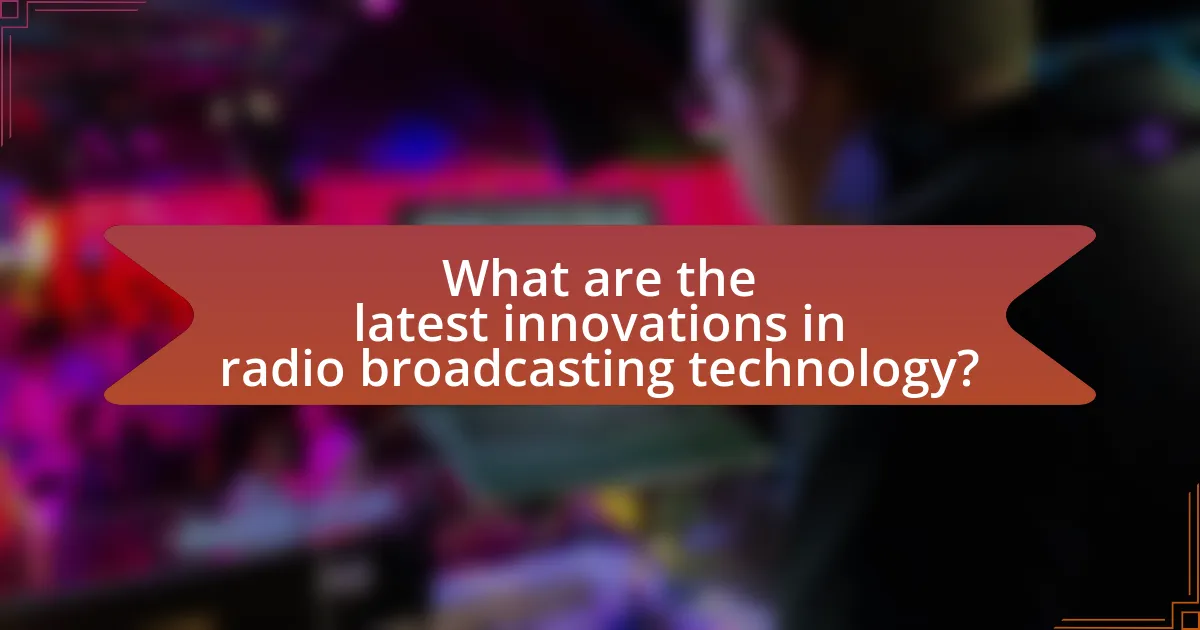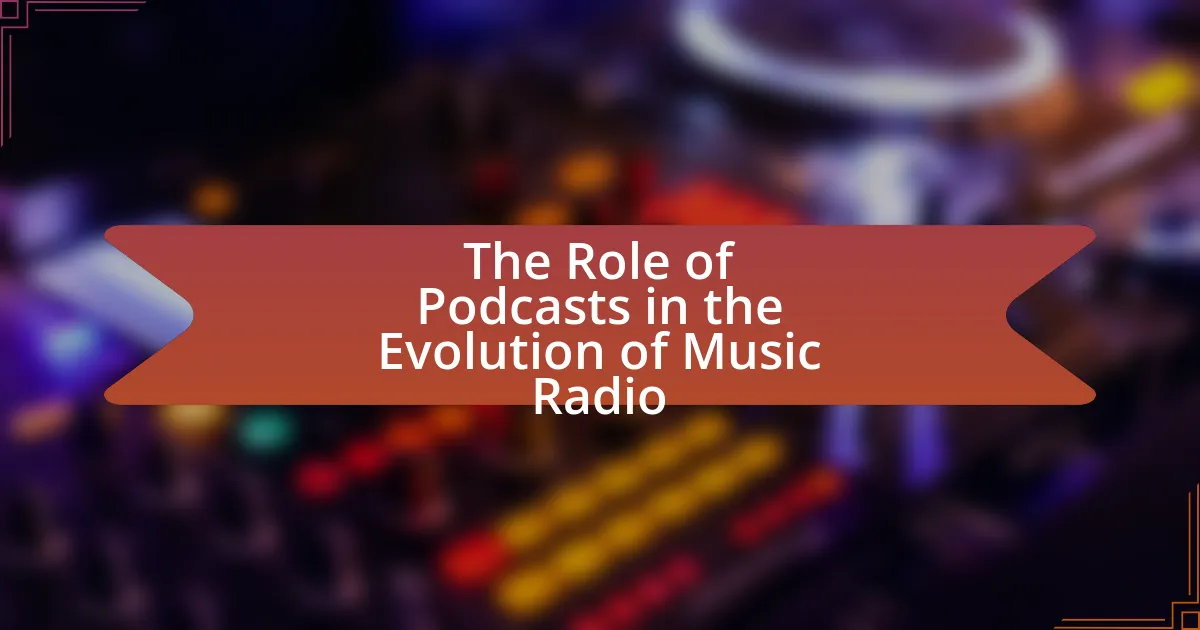The article focuses on the latest innovations in radio broadcasting technology, highlighting key advancements such as digital audio broadcasting (DAB), enhanced streaming capabilities, and the integration of artificial intelligence for personalized content. It discusses how digital advancements have transformed radio by improving audio quality and expanding accessibility through internet radio and podcasting. The role of social media in enhancing audience engagement and the impact of emerging technologies like 5G are also examined. Additionally, the article addresses the challenges broadcasters face in adopting new technologies and the importance of innovation for maintaining competitiveness in a rapidly evolving media landscape.

What are the latest innovations in radio broadcasting technology?
The latest innovations in radio broadcasting technology include the adoption of digital audio broadcasting (DAB), advancements in streaming capabilities, and the integration of artificial intelligence for content personalization. Digital audio broadcasting enhances sound quality and allows for more channels within the same frequency, as evidenced by its widespread implementation in Europe and parts of Asia. Streaming capabilities have improved with the rise of internet radio, enabling listeners to access content globally, supported by statistics showing that over 50% of radio listening in the U.S. now occurs via digital platforms. Additionally, artificial intelligence is being utilized to analyze listener preferences and automate content curation, which has been shown to increase listener engagement by up to 30%.
How have digital advancements transformed radio broadcasting?
Digital advancements have significantly transformed radio broadcasting by enabling streaming services, enhancing audio quality, and facilitating interactive content. The transition from analog to digital broadcasting has allowed for higher fidelity sound and the ability to transmit multiple channels over the same frequency, improving listener experience. For instance, digital audio broadcasting (DAB) provides clearer sound and more programming options compared to traditional AM/FM radio. Additionally, the rise of internet radio and podcasting has expanded the reach of radio content, allowing listeners to access broadcasts on-demand and from anywhere in the world. According to a report by the Pew Research Center, as of 2021, 41% of Americans aged 12 and older listen to online radio weekly, highlighting the shift in consumption patterns driven by digital technology.
What role does streaming technology play in modern radio?
Streaming technology is essential in modern radio as it enables real-time broadcasting over the internet, expanding accessibility and audience reach. This technology allows radio stations to stream their content live, making it available to listeners globally, regardless of geographical limitations. According to a report by the Pew Research Center, as of 2021, 41% of Americans aged 12 and older listen to online radio weekly, highlighting the significant shift towards digital platforms. Additionally, streaming facilitates on-demand content, allowing users to access past shows and podcasts, which enhances listener engagement and satisfaction.
How has the integration of social media impacted radio broadcasting?
The integration of social media has significantly transformed radio broadcasting by enhancing audience engagement and expanding reach. Radio stations now utilize platforms like Twitter, Facebook, and Instagram to interact with listeners in real-time, allowing for immediate feedback and participation during broadcasts. This shift has led to increased listener loyalty, as audiences feel more connected to their favorite shows and hosts. According to a 2021 Nielsen report, 62% of radio listeners engage with stations on social media, indicating a strong correlation between social media interaction and listener retention. Additionally, social media serves as a promotional tool, enabling radio stations to share content, announce events, and attract new audiences, thereby broadening their market presence.
What are the emerging trends in radio broadcasting technology?
Emerging trends in radio broadcasting technology include the adoption of digital audio broadcasting (DAB), the integration of artificial intelligence (AI) for content personalization, and the expansion of internet radio and streaming services. DAB offers improved sound quality and more efficient use of bandwidth compared to traditional analog broadcasting. AI enhances user experience by analyzing listener preferences and tailoring content accordingly, which is evidenced by platforms like Spotify and Pandora. Additionally, the rise of internet radio, with services such as TuneIn and iHeartRadio, reflects a shift towards on-demand and mobile listening, allowing users to access a wider variety of content anytime and anywhere.
How is artificial intelligence being utilized in radio broadcasting?
Artificial intelligence is utilized in radio broadcasting primarily for content creation, audience engagement, and operational efficiency. AI algorithms analyze listener preferences and behaviors to curate personalized playlists and recommend programming, enhancing user experience. For instance, AI-driven tools can automate news reporting by generating scripts based on real-time data, as seen in applications like Reuters’ AI news service. Additionally, AI chatbots facilitate listener interaction, providing instant responses and fostering community engagement. According to a report by PwC, 77% of media executives believe AI will significantly impact their industry, underscoring its growing role in transforming radio broadcasting.
What advancements are being made in audio quality and transmission?
Advancements in audio quality and transmission include the development of high-resolution audio formats and improved streaming technologies. High-resolution audio formats, such as FLAC and DSD, provide greater detail and fidelity compared to standard formats, allowing listeners to experience music as intended by the artists. Additionally, advancements in streaming technologies, including adaptive bitrate streaming, enhance audio quality by adjusting the bitrate based on network conditions, ensuring a seamless listening experience. These improvements are supported by the increasing availability of high-bandwidth internet connections and the proliferation of devices capable of playing high-resolution audio, which collectively contribute to a significant enhancement in audio quality and transmission efficiency.
Why is innovation crucial for the future of radio broadcasting?
Innovation is crucial for the future of radio broadcasting because it enables the industry to adapt to changing consumer preferences and technological advancements. As digital platforms and streaming services gain popularity, traditional radio must innovate to remain relevant and competitive. For instance, the rise of podcasting and on-demand audio has transformed how audiences consume content, necessitating radio broadcasters to integrate similar features and enhance interactivity. Furthermore, advancements in technology, such as artificial intelligence and data analytics, allow for personalized content delivery, improving listener engagement and satisfaction. According to a report by the Pew Research Center, 41% of Americans aged 12 and older listen to online radio weekly, highlighting the need for innovation to capture and retain this audience.
How does competition with other media influence radio innovation?
Competition with other media drives radio innovation by compelling broadcasters to adopt new technologies and formats to retain audience engagement. For instance, the rise of streaming services and podcasts has prompted traditional radio stations to enhance their digital presence, leading to the development of mobile apps and on-demand content. According to a 2021 Nielsen report, over 50% of Americans listen to online radio, indicating that traditional radio must innovate to compete effectively. This competitive pressure encourages radio to explore interactive features, personalized content, and improved audio quality, ensuring it remains relevant in a rapidly evolving media landscape.
What are the potential risks of not innovating in radio broadcasting?
The potential risks of not innovating in radio broadcasting include loss of audience engagement, decreased advertising revenue, and obsolescence in a competitive media landscape. Without innovation, radio stations may fail to attract younger listeners who prefer digital platforms, leading to a decline in listener numbers. According to a 2021 Nielsen report, 18-34-year-olds are increasingly turning to streaming services, which poses a direct threat to traditional radio’s relevance. Additionally, stagnant content and technology can result in reduced advertising opportunities, as advertisers seek platforms that offer better targeting and engagement metrics. Ultimately, failure to innovate can lead to a diminished market presence, as competitors adopt new technologies and formats that resonate with audiences.

What technologies are shaping the future of radio broadcasting?
Digital audio broadcasting (DAB) and internet streaming are the primary technologies shaping the future of radio broadcasting. DAB enhances audio quality and allows for more channels within the same bandwidth, while internet streaming provides global access and on-demand content. According to the European Broadcasting Union, DAB usage has increased significantly, with over 50% of households in some countries now equipped for DAB reception. Additionally, the rise of smart speakers and mobile applications has transformed how audiences engage with radio, allowing for personalized listening experiences and interactive content. These advancements indicate a shift towards more versatile and accessible radio broadcasting formats.
How is 5G technology expected to impact radio broadcasting?
5G technology is expected to significantly enhance radio broadcasting by enabling higher data transmission rates and lower latency. This advancement allows for improved audio quality, real-time broadcasting capabilities, and the potential for interactive content delivery. For instance, 5G’s ability to support massive device connectivity can facilitate the integration of IoT devices in broadcasting, leading to personalized listener experiences. Additionally, the increased bandwidth can accommodate high-definition audio streaming, which is projected to attract more listeners and advertisers.
What advantages does 5G offer for radio content delivery?
5G offers significant advantages for radio content delivery, primarily through enhanced speed, lower latency, and increased capacity. The high data transfer rates of 5G, which can reach up to 10 Gbps, enable seamless streaming of high-quality audio and multimedia content. Additionally, the reduced latency, often below 1 millisecond, allows for real-time interactions and live broadcasting without delays. Furthermore, 5G’s ability to connect a vast number of devices simultaneously supports more users accessing radio content without degradation in service quality, facilitating a more robust and reliable listening experience. These features collectively enhance the overall efficiency and effectiveness of radio content delivery.
How will 5G change listener experiences in radio broadcasting?
5G will significantly enhance listener experiences in radio broadcasting by enabling higher audio quality, lower latency, and more interactive content. With 5G’s increased bandwidth, radio stations can stream high-definition audio without interruptions, improving sound clarity and overall listening enjoyment. Additionally, the reduced latency allows for real-time interactions, such as live listener polls and instant feedback during broadcasts, fostering a more engaging experience. According to a report by the GSMA, 5G networks can support up to 1 million devices per square kilometer, which means radio stations can reach a larger audience simultaneously without compromising quality. This technological advancement will transform traditional radio into a more dynamic and immersive medium.
What role does podcasting play in the evolution of radio?
Podcasting plays a transformative role in the evolution of radio by expanding the medium’s accessibility and content diversity. Unlike traditional radio, which is often bound by time slots and geographic limitations, podcasting allows listeners to access a wide range of topics on-demand, fostering a more personalized listening experience. According to Edison Research, as of 2023, over 80 million Americans listen to podcasts monthly, indicating a significant shift in audio consumption habits. This growth in podcasting has prompted traditional radio stations to adapt by incorporating podcast formats and on-demand content, thereby blending the two mediums and enhancing their relevance in a digital age.
How are traditional radio stations adapting to the podcasting trend?
Traditional radio stations are adapting to the podcasting trend by creating their own podcast content and integrating it into their programming. This shift allows them to reach a broader audience and cater to on-demand listening preferences. For instance, many stations are repurposing popular radio segments into podcast episodes, which enables them to leverage existing content while attracting listeners who prefer the flexibility of podcasts. Additionally, according to a report by Edison Research, 41% of Americans aged 12 and older have listened to a podcast in the past month, highlighting the growing popularity of this medium and encouraging radio stations to innovate their offerings to remain competitive.
What are the benefits of integrating podcasts into radio programming?
Integrating podcasts into radio programming enhances audience engagement and expands content diversity. This integration allows radio stations to reach a broader demographic, as podcasts cater to niche interests and preferences that traditional radio may not cover. According to a 2021 report by Edison Research, 41% of Americans aged 12 and older have listened to a podcast in the past month, indicating a growing audience that radio can tap into. Additionally, podcasts provide on-demand content, allowing listeners to consume material at their convenience, which complements the live nature of radio broadcasts. This combination can lead to increased listener retention and loyalty, as audiences appreciate the flexibility and variety offered by both formats.
How are smart devices influencing radio broadcasting?
Smart devices are significantly influencing radio broadcasting by enabling on-demand access to content and personalized listening experiences. With the proliferation of smartphones, smart speakers, and connected devices, listeners can stream radio stations, podcasts, and music services anytime and anywhere, leading to a decline in traditional radio listenership. According to a Nielsen report, 62% of Americans aged 18-34 listen to online radio, highlighting the shift towards digital platforms facilitated by smart devices. This trend compels radio broadcasters to adapt their strategies, focusing on digital content delivery and audience engagement through apps and social media integration.
What features do smart speakers offer for radio listening?
Smart speakers offer features such as voice control, streaming capabilities, and integration with radio apps for radio listening. Voice control allows users to easily request specific stations or genres without manual input, enhancing convenience. Streaming capabilities enable access to a wide range of online radio stations and podcasts, expanding listening options beyond traditional AM/FM broadcasts. Additionally, integration with popular radio apps like TuneIn and iHeartRadio allows users to discover and listen to various content seamlessly. These features collectively enhance the radio listening experience by providing accessibility, variety, and ease of use.
How can radio stations leverage smart technology for audience engagement?
Radio stations can leverage smart technology for audience engagement by utilizing interactive applications and personalized content delivery. These technologies enable stations to create mobile apps that allow listeners to interact in real-time, participate in polls, and access on-demand content tailored to their preferences. For instance, according to a 2021 Nielsen report, 60% of radio listeners engage with stations through mobile apps, highlighting the effectiveness of this approach. Additionally, integrating artificial intelligence can help analyze listener data to further customize programming and advertising, enhancing the overall listener experience.

What challenges do radio broadcasters face in adopting new technologies?
Radio broadcasters face significant challenges in adopting new technologies, primarily due to financial constraints, the need for staff training, and the rapid pace of technological change. Financial limitations often hinder broadcasters from investing in the latest equipment and software, which can lead to outdated broadcasting methods. Additionally, the transition to new technologies requires comprehensive training for staff, which can be time-consuming and costly. The rapid evolution of technology also poses a challenge, as broadcasters must continuously adapt to new platforms and tools to remain competitive, risking obsolescence if they fail to keep up. These factors collectively impede the effective integration of innovative technologies in radio broadcasting.
What are the financial implications of upgrading broadcasting technology?
Upgrading broadcasting technology incurs significant financial implications, including initial capital investment, ongoing operational costs, and potential revenue increases. The initial capital investment can range from thousands to millions of dollars, depending on the scale of the upgrade, such as transitioning from analog to digital systems or implementing advanced transmission equipment. Ongoing operational costs may rise due to maintenance, training, and energy consumption associated with new technologies. However, these upgrades can lead to increased revenue through enhanced advertising opportunities, improved audience reach, and the ability to offer premium content, which can attract more listeners and advertisers. For instance, a study by the National Association of Broadcasters found that stations upgrading to digital broadcasting experienced a 20% increase in advertising revenue within the first year post-upgrade.
How can radio stations manage the costs of technological innovation?
Radio stations can manage the costs of technological innovation by adopting a strategic approach that includes prioritizing essential upgrades, leveraging partnerships, and exploring funding opportunities. By focusing on critical technologies that enhance listener engagement and operational efficiency, radio stations can allocate resources effectively. Collaborating with technology providers or other media organizations can lead to shared costs and access to advanced solutions without significant financial burden. Additionally, seeking grants or sponsorships specifically aimed at technological advancements in broadcasting can provide necessary financial support, as evidenced by the National Association of Broadcasters’ initiatives that have funded various technological upgrades in the industry.
What funding options are available for radio technology upgrades?
Funding options for radio technology upgrades include federal grants, state funding programs, private investments, and crowdfunding. Federal grants, such as those from the National Telecommunications and Information Administration (NTIA), provide financial support specifically for technology improvements in broadcasting. State funding programs often allocate resources for local media upgrades, while private investments can come from venture capitalists interested in media technology. Crowdfunding platforms allow radio stations to raise funds directly from their audience, enabling community support for technological advancements. These funding avenues are essential for enhancing radio technology and ensuring stations remain competitive in a rapidly evolving media landscape.
How do regulatory issues affect radio broadcasting innovations?
Regulatory issues significantly hinder radio broadcasting innovations by imposing restrictions on frequency allocations, content regulations, and technological advancements. For instance, the Federal Communications Commission (FCC) in the United States enforces strict licensing requirements that can delay the introduction of new broadcasting technologies, such as digital radio or streaming services. These regulations can limit the ability of broadcasters to experiment with innovative formats or adopt new technologies, ultimately stifling creativity and competition in the industry. Additionally, compliance with regulatory standards often requires substantial financial investment, diverting resources away from innovation initiatives.
What are the key regulations impacting radio technology advancements?
Key regulations impacting radio technology advancements include the Federal Communications Commission (FCC) rules in the United States, which govern spectrum allocation, licensing, and interference management. These regulations ensure efficient use of the radio frequency spectrum, which is critical for the development of new technologies such as digital broadcasting and mobile communications. Additionally, international agreements like the ITU Radio Regulations facilitate global coordination of frequency use, preventing cross-border interference and promoting technological innovation. Compliance with these regulations is essential for companies to deploy new radio technologies effectively and legally.
How can broadcasters navigate compliance while innovating?
Broadcasters can navigate compliance while innovating by implementing robust regulatory frameworks that align with technological advancements. This involves staying informed about current regulations, such as the Federal Communications Commission (FCC) guidelines in the United States, which govern broadcasting standards and practices. By integrating compliance checks into the innovation process, broadcasters can ensure that new technologies, such as digital streaming and data analytics, adhere to legal requirements. For instance, the adoption of automated content recognition technology must comply with copyright laws to avoid infringement. Additionally, engaging with legal experts and industry associations can provide broadcasters with insights into best practices and emerging compliance challenges, enabling them to innovate responsibly while minimizing legal risks.
What strategies can radio broadcasters employ to overcome these challenges?
Radio broadcasters can employ several strategies to overcome challenges, including adopting digital platforms, enhancing audience engagement through interactive content, and utilizing data analytics for targeted programming. By transitioning to digital platforms, broadcasters can reach wider audiences and adapt to changing listening habits, as evidenced by the increase in online streaming and podcasting, which accounted for over 50% of audio consumption in recent years. Enhancing audience engagement through interactive content, such as social media integration and listener polls, fosters community and loyalty, which is crucial in a competitive landscape. Additionally, utilizing data analytics allows broadcasters to tailor their content to listener preferences, improving retention and satisfaction, as demonstrated by stations that have successfully implemented listener feedback mechanisms to refine their programming.
How can collaboration with tech companies enhance radio innovation?
Collaboration with tech companies can enhance radio innovation by integrating advanced technologies such as artificial intelligence, data analytics, and streaming capabilities into radio broadcasting. This partnership allows radio stations to leverage AI for personalized content delivery, improving listener engagement through tailored programming based on user preferences. For instance, companies like Spotify have utilized data analytics to refine their music recommendation algorithms, which can be adapted by radio stations to create more relevant playlists. Furthermore, tech companies can provide infrastructure for high-quality streaming, enabling radio stations to reach broader audiences and compete with digital platforms. This synergy not only modernizes traditional radio but also fosters the development of new formats and interactive features, ultimately driving growth in the industry.
What best practices should radio stations follow to stay competitive?
Radio stations should adopt a multi-platform approach to stay competitive. This involves integrating traditional broadcasting with digital platforms, such as streaming services and social media, to reach a broader audience. According to a Nielsen report, 93% of Americans still listen to radio weekly, but digital platforms are increasingly important, with over 50% of listeners using online streaming services. By leveraging data analytics, radio stations can better understand listener preferences and tailor content accordingly, enhancing engagement and loyalty. Additionally, investing in high-quality content and innovative programming, such as podcasts and live events, can differentiate a station from competitors and attract new listeners.





